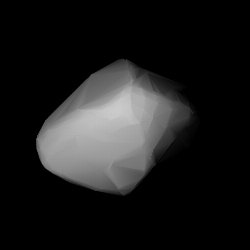1422 Strömgrenia
 Shape model of Strömgrenia from its lightcurve | |
| Discovery[1] | |
|---|---|
| Discovered by | K. Reinmuth |
| Discovery site | Heidelberg Obs. |
| Discovery date | 23 August 1936 |
| Designations | |
| (1422) Stromgrenia | |
Named after | Elis Strömgren (astronomer)[2] |
| 1936 QF · 1933 WB | |
| main-belt · Flora[3] | |
| Orbital characteristics[1] | |
| Epoch 16 February 2017 (JD 2457800.5) | |
| Uncertainty parameter 0 | |
| Observation arc | 79.76 yr (29,134 days) |
| Aphelion | 2.6241 AU |
| Perihelion | 1.8697 AU |
| 2.2469 AU | |
| Eccentricity | 0.1679 |
| 3.37 yr (1,230 days) | |
| 291.18° | |
| 0° 17m 33.36s / day | |
| Inclination | 2.6809° |
| 201.61° | |
| 171.15° | |
| Physical characteristics | |
| Dimensions | 4.64±0.66 km[4] 4.87±0.34 km[5] 5.62 km (calculated)[3] 5.814±0.113 km[6] 6.025±0.027 km[7] |
| 3.5002±0.0102 h (S)[3][8] 3.5298±0.0285 h (R)[8] | |
| 0.2093±0.0364[7] 0.224±0.022 0.24 (assumed)[3] 0.320±0.045[5] 0.40±0.12[4] | |
| B–V = 0.868[1] U–B = 0.519[1] Tholen = S[1] · S[3][9] | |
| 13.051±0.003 (R)[8] · 13.06±0.28[9] · 13.42[1][3][4][5][7] | |
1422 Strömgrenia, provisional designation 1936 QF, is a stony Florian asteroid from the inner regions of the asteroid belt, approximately 5.5 kilometers in diameter. It was discovered on 23 August 1936, by German astronomer Karl Reinmuth at Heidelberg Observatory in southern Germany, and named after Swedish-Danish astronomer Svante Elis Strömgren.[2][10]
Classification and orbit
[edit]Strömgrenia is a member of the Flora family, a large group of stony asteroids in the inner main-belt. It orbits the Sun at a distance of 1.9–2.6 AU once every 3 years and 4 months (1,230 days). Its orbit has an eccentricity of 0.17 and an inclination of 3° with respect to the ecliptic.[1] It was first identified as 1933 WB at Uccle Observatory in 1933. The body's observation arc however begins with its official discovery observation at Heidelberg in 1936.[10]
Lightcurves
[edit]Two rotational light-curves of Strömgrenia were obtained from photometric observations in the R and S band at the Palomar Transient Factory in April 2009. Light-curve analysis gave a rotation period of 3.5002 and 3.5298 hours with a brightness variation of 0.24 and 0.29 magnitude, respectively (U=2/2).[8]
Diameter, albedo and spectral type
[edit]On the Tholen taxonomy, Strömgrenia's spectral class is that of a S-type. According to the survey carried out by NASA's Wide-field Infrared Survey Explorer with its subsequent NEOWISE mission, it measures between 4.64 and 6.03 kilometers in diameter, and its surface has an albedo between 0.209 and 0.40.[4][5][6][7] The Collaborative Asteroid Lightcurve Link, assumes an albedo of 0.24 – derived from the asteroid 8 Flora, the family's principal body and namesake – and calculates a diameter of 5.62 kilometers with an absolute magnitude of 13.42.[3]
Naming
[edit]This minor planet was named in honor of Swedish-Danish astronomer Svante Elis Strömgren (1870–1947), professor of astronomy and director of the Copenhagen University Observatory.[2] Naming citation was first mentioned in The Names of the Minor Planets by Paul Herget in 1955 (H 128).[2]
References
[edit]- ^ a b c d e f g "JPL Small-Body Database Browser: 1422 Stromgrenia (1936 QF)" (2016-05-30 last obs.). Jet Propulsion Laboratory. Archived from the original on 18 September 2020. Retrieved 8 January 2017.
- ^ a b c d Schmadel, Lutz D. (2007). "(1422) Strömgrenia". Dictionary of Minor Planet Names – (1422) Strömgrenia. Springer Berlin Heidelberg. p. 114. doi:10.1007/978-3-540-29925-7_1423. ISBN 978-3-540-00238-3.
- ^ a b c d e f g "LCDB Data for (1422) Strömgrenia". Asteroid Lightcurve Database (LCDB). Retrieved 8 January 2017.
- ^ a b c d Nugent, C. R.; Mainzer, A.; Masiero, J.; Bauer, J.; Cutri, R. M.; Grav, T.; et al. (December 2015). "NEOWISE Reactivation Mission Year One: Preliminary Asteroid Diameters and Albedos". The Astrophysical Journal. 814 (2): 13. arXiv:1509.02522. Bibcode:2015ApJ...814..117N. doi:10.1088/0004-637X/814/2/117. Retrieved 8 January 2017.
- ^ a b c d Masiero, Joseph R.; Mainzer, A. K.; Grav, T.; Bauer, J. M.; Cutri, R. M.; Nugent, C.; et al. (November 2012). "Preliminary Analysis of WISE/NEOWISE 3-Band Cryogenic and Post-cryogenic Observations of Main Belt Asteroids". The Astrophysical Journal Letters. 759 (1): 5. arXiv:1209.5794. Bibcode:2012ApJ...759L...8M. doi:10.1088/2041-8205/759/1/L8. Retrieved 8 January 2017.
- ^ a b Masiero, Joseph R.; Mainzer, A. K.; Grav, T.; Bauer, J. M.; Cutri, R. M.; Dailey, J.; et al. (November 2011). "Main Belt Asteroids with WISE/NEOWISE. I. Preliminary Albedos and Diameters". The Astrophysical Journal. 741 (2): 20. arXiv:1109.4096. Bibcode:2011ApJ...741...68M. doi:10.1088/0004-637X/741/2/68. Retrieved 8 January 2017.
- ^ a b c d Mainzer, A.; Grav, T.; Masiero, J.; Hand, E.; Bauer, J.; Tholen, D.; et al. (November 2011). "NEOWISE Studies of Spectrophotometrically Classified Asteroids: Preliminary Results". The Astrophysical Journal. 741 (2): 25. arXiv:1109.6407. Bibcode:2011ApJ...741...90M. doi:10.1088/0004-637X/741/2/90.
- ^ a b c d Waszczak, Adam; Chang, Chan-Kao; Ofek, Eran O.; Laher, Russ; Masci, Frank; Levitan, David; et al. (September 2015). "Asteroid Light Curves from the Palomar Transient Factory Survey: Rotation Periods and Phase Functions from Sparse Photometry". The Astronomical Journal. 150 (3): 35. arXiv:1504.04041. Bibcode:2015AJ....150...75W. doi:10.1088/0004-6256/150/3/75. Retrieved 8 January 2017.
- ^ a b Veres, Peter; Jedicke, Robert; Fitzsimmons, Alan; Denneau, Larry; Granvik, Mikael; Bolin, Bryce; et al. (November 2015). "Absolute magnitudes and slope parameters for 250,000 asteroids observed by Pan-STARRS PS1 - Preliminary results". Icarus. 261: 34–47. arXiv:1506.00762. Bibcode:2015Icar..261...34V. doi:10.1016/j.icarus.2015.08.007. Retrieved 8 January 2017.
- ^ a b "1422 Stromgrenia (1936 QF)". Minor Planet Center. Retrieved 8 January 2017.
External links
[edit]- Asteroid Lightcurve Database (LCDB), query form (info Archived 16 December 2017 at the Wayback Machine)
- Dictionary of Minor Planet Names, Google books
- Asteroids and comets rotation curves, CdR – Observatoire de Genève, Raoul Behrend
- Discovery Circumstances: Numbered Minor Planets (1)-(5000) – Minor Planet Center
- 1422 Strömgrenia at AstDyS-2, Asteroids—Dynamic Site
- 1422 Strömgrenia at the JPL Small-Body Database
